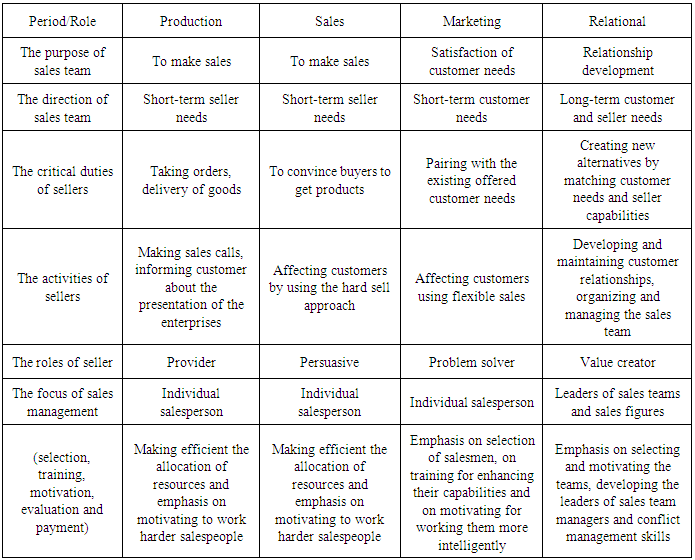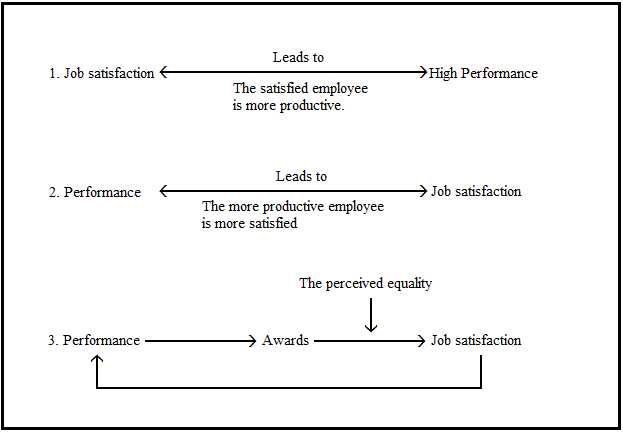-
Paper Information
- Paper Submission
-
Journal Information
- About This Journal
- Editorial Board
- Current Issue
- Archive
- Author Guidelines
- Contact Us
International Journal of Finance and Accounting
p-ISSN: 2168-4812 e-ISSN: 2168-4820
2015; 4(4): 195-205
doi:10.5923/j.ijfa.20150404.01
Impact of Sales Team on Job Satisfaction According to Organizational Commitment
Nevzat Demir
Nevzat Demir Fırat Plastik Corporation Türkoba Quarter Fırat Plastik Avenue Istanbul, Turkey
Correspondence to: Nevzat Demir, Nevzat Demir Fırat Plastik Corporation Türkoba Quarter Fırat Plastik Avenue Istanbul, Turkey.
| Email: |  |
Copyright © 2015 Scientific & Academic Publishing. All Rights Reserved.
The most important problem faced by the enterprises in today's economy that competition has increased in a very poignantly, is able to buy the produced goods, not to produce. Nowadays the success of enterprises in marketing activities is based largely on team work rather than individual. As is known, the teamwork directs the individuals with different skills and expertise to the common goals. Therefore, it is possible to talk about the many advantages of teamwork; In this context, businesses having sales teams do not have the great advantages and the opportunity to better meet many different and complex consumer demand and needs. It has not been focused on job satisfaction and organizational commitments of the members in the sales team, these concepts have not been studied sufficiently. Whereas, these concepts have been studied and investigated intensively in the field of organizational behavior. In this study, firstly, the concepts of sales, team and sales teams will be analyzed and then the concepts of job satisfaction and organizational commitment will be examined in detail.
Keywords: Sales Teams, Job Satisfaction, Organizational Commitment, Organizational strategy
Cite this paper: Nevzat Demir, Impact of Sales Team on Job Satisfaction According to Organizational Commitment, International Journal of Finance and Accounting , Vol. 4 No. 4, 2015, pp. 195-205. doi: 10.5923/j.ijfa.20150404.01.
Article Outline
1. Introduction
- The persistence and the protection of market shares of enterprises becomes more difficult from day to day in the rapidly changing and developing world economy. Producing is no longer a problem for the enterprises however, ''sales'' or '' to sell the produced'' has become more important. For this reason, individual salesmen in enterprises and working these salesmen in a ''team'' or ''staff'' is one of the most important factors in the emergence of success. As it is known, marketing functions in enterprises and sales activities carried out depending on this function are of prime importance in achieving business revenues. Such a feature increases the importance of the marketing and sales activities. On the other hand, some additional benefits of teams will be obtained with working of salesmen as a team. The efforts of salesmen may be coordinated in a common goal frame and more efficient and effective operations may be done and more positive results may be obtained. In this context, job satisfaction and organizational commitment concepts in sales teams are important concepts to be considered in the success of the members forming the sales teams.
2. Personal Sales, Team and Sales Teams
2.1. Personal Sales and Salesperson
- Personal sales which is one of the promotional mix elements is of paramount importance for businesses. Personal sales is defined as mutual talk, discuss and reach conclusion with one or more potential buyer in order to make sales (Mucuk, 2004). Personal sales is the personal representation of enterprise by the sales force for the purpose of improving customer relationships and making sales. (Kotler and Armstrong, 2012). Personal sales which is the marketing activities requires face to face contact with customers. (Jobber, 2007). As distinct from advertising, sponsorships, and other non-personal forms of communication, the personal sales requires direct interaction between buyers and sellers (Jobber, 2007). This two-way communication means the seller, the buyer's ability to understand the special needs and problems and to make a personalized sales presentation with this information. (Jobber, 2007). In other words, it can be said that the use of personal sales in complex sales situations will be more effective compared to one-way communication such as the advertising. (Kotler et al., 2003). As personal sales can be carried out face to face, it can be carried out by telephone, video conferencing channel and other ways. (Kotler et al., 2003). Personal sales process can be summarized in the following stages. (Kotler and Armstrong, 2012);Identifying potential customers,Investigating the characteristics of potential customers to be made sales,For the first time, coming together with the customer,Making presentations to customers and transferring the value of the offered product,Answering the question of customer related to the offered product,Taking orders from customers,Monitoring customer after sales.Salesperson is an enterprise employee involved in one or more stages in the personal sales process given above. Therefore Salesperson term corresponds to a wide variety of positions in enterprises. (Kotler and Armstrong, 2012). For example, while salesperson in retail stores is people being in interaction with consumers and taking orders, the task of salesperson marketing industrial equipment includes the development of the relationship with industrial customers.
|
2.2. Team Concept
- Team concept is defined as the community consisted of two and more individual which has come together to reach a predetermined targets, being interdependent and acting together. As is also understood from definition, two or more people for the formation of the team, interdependence and interaction of team members and willingness to work to achieve a certain objective shared are in question (Eren, 2004) Team with another approach; are continuously working group created in order to provide a common purpose and commitment at all levels of the organization and to provide a functional integrity within the organization (Coffey et al, 1994). Although each of team members has the expertise in different areas, members need each other's experience and strength for being more effective. Eventually members have to work together in a group in order to get the most appropriate decisions and to achieve common goals. Managers are temporary or permanent members of many teams in organizations. Managers have two roles in teams. First of them is the leader of team, second one is the membership of team. A manager included as a subordinate in a group can serve as a chief in another group. Thus, a manager in a different position in two different group can serve for a binding function between the two groups. (Coffey et al, 1994).Today, the team concept is used as distinct from the concept of group by some authors. Group is defined as a social phenomenon sharing common norms and principles of conduct, performing the a variety of role differentiation between them, sharing a common goal and being in communication with each other for this purpose, mutually affecting each other, emerging with coming together two or more people. (Koçel, 2005).As seen in the above definitions, team and group concepts are expressed with very close definitions to each other. Today, however some authors have said that they are different from each other and each of group is not team although the group and team concepts show similarity. According to these authors, a team must have some additional features for being team. These features are as follows: (Koçel, 2005): ● The presence of leadership as a shared activity, ● The presence of the group's unique purpose and mission, ● Adopting problem solving as the life style of the group,● Being made the effectiveness measurement with the common products and output of group. The most important element is the presence of a common and shared purpose in group and team concepts. In this regard, it must work together to achieve the goal which can be achieved with the participation of all members in the team. Specific requirements, benefits and risks of the team arise regarding at least one target required joint efforts. Because the target or targets must be understood in the same way by all team members and the effort and strive of each member must be coordinated. Eventually, benefits resulting from a successful cooperation and solidarity also arise as there are some risks in high interaction and communication level. (Hardingham, 1997).An opportunity is not in question as no need for a collective work in the business groups. It is aimed to be successful in individual terms. In contrast, it is provided that team members must make an effort above their individual entries by creating a positive synergy in teamwork. Thus, overall performance level of the employees is increased. The differences between teams and groups are seen in Figure 1 (Robbins, 2003).
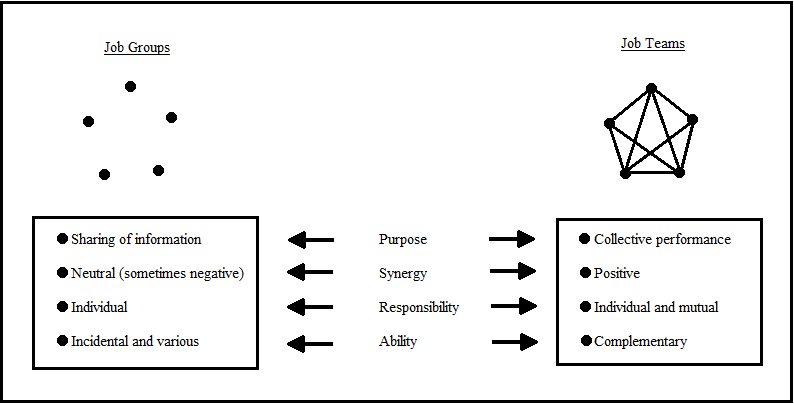 | Figure 1. Comparison of Business Team and Business Groups. Reference: Robbins, S.P.(2003). Organizational Behavior. Tenth Edition. New, Jersey: Prentice Hall, 258. (Robbins, 2003) |
2.2.1. Formation Stages of Teams
- Teams do not occur in a moment. Becoming a team of human groups which have come together is possible by passing through various stages over time. Throughout the process involving these stages, members have the chance to better know and understand each other. Thus, it is possible to make works better. Tuckman and Jensen have classified the formation process, as the establishment phase, remodeling phase, succeeding phase and dispersion phase of teams (Body et al, 1998).● Establishment Phase. This stage starts with the selection of members that will join the team. Team manager selects members that will form teams according to functional, technical or other specialties. At this stage, members try to know each other, to have an exchange of ideas and put their ideas about what the team should do. Members try to impose their identities in team● Confusion (crisis) Phase. Conflicts, confusion and chaos occurs at this stage. This is a stage where there is maximum inconvenience for the team. Members realize that they have different requests, interest and priorities from other members of the team. Different personalities and opposing attitudes reveal. But, over time, The value and rules brought to the team with members are clear. Some teams can not complete satisfactory and successfully this stage. In such a case, the disagreements, differences should be discussed openly and uncertainties should be eliminated. ● Forming Phase. Harmony and reconciliation is provided in team by eliminating differences at this stage, better ways of working are revealed together. Shared rules, values and behavior pattern sets are developed. Members' duties and responsibilities are clarified, a common language is developed to work and communicate the members better. ● Succeeding Phase. In the succeeding stage, the team works to achieve the objectives in the required standards. At this stage, the team members adopt each other, the objectives of the team, team values and behavior patterns and rules.● Dispersion phase. At this stage, the team's tasks are completed and the team is dispersed.Creating new teams composed of new members instead of making changes in the existing teams is both easier and more effective. In this way, it is easier to break or resolve the resistance of the former members. Meanwhile, the obstacles not be destroyed, bad habits, destructive attitudes, improper business relations or procedures should not be between the newly formed teams. Therefore four steps may be followed to a successful start in a new team: In the first step, all realistic features should be clarified for each member, the members of team should be aware of the compliance with other work and responsibility for entering team. In the second steps, the members should share their expectations, interests and concerns as a team. In the third step, individual and team goals should be set out in an open format. In the fourth step, decision-making, participation, methods of doing business, managing and resolving conflicts, work completion and operation principles and team development processes should be formulated. (Coffey et al, 1994).Margerison and McCann have suggested that some processes should be followed in order to form a team with high-performance and energy. The newly formed teams should answer them by taking the time to some of the following questions, It should be provided thorough understanding of these questions by the team members and reaching consensus on. (Coffey et al, 1994): ● Who are we? When team members share strengths and weaknesses, work preferences, values and beliefs with the other members, the differences are tried to eliminate without causing conflict. Thus, shared beliefs create a group identity, they realize being together. ● Where are we? As is known, a team has strong or weak aspects. However, the teams give priority to aspects which they have strong and gained an advantage, and they neglect their weaknesses and do not take into consideration. However, teams should also assess the elements including opportunities and risks by taking into account the weaknesses as much as strengths. ● Where are we going? Teams should have missions, purposes and targets which they will reach. Teams should consider what they will look like in next one, two or five years. ● How to get to the place we want to reach? Depending on the task or objective, the teams should create specific team goals and integrate them with the goals of the members. It should be determined who will do, what to do and how to do and they will get help from which parts, the results should follow and their performances should be evaluated by measuring. ● What is waiting for us? The teams show better performance when they know what is expected of them. Therefore, the teams should know their roles, responsibilities and powers in the team. ● Where can I get support I need? Each member's training and development needs, strengths and weaknesses of members, the opportunity and the hazards analyzes affect the success of the team, thus it positively affect the success of the team.● How effective are we? Performance evaluations conducted regularly in terms of quantity or quality indicate whether the team has achieved to the desired objectives. Also these indicators reveal whether they have achieved to the expected or desired standard. ● Eventually, how can we receive a reward? Teams have prizes expectations as in managers. Awards are given to teams, congratulations can be in the form of financial and promotions.
2.2.2. Basic Features of Successful Teams
- The role and importance of teamwork is great, in being made more effective and efficient the activities by the enterprises. There are major responsibilities of team manager in creating successful teams, maintaining success. Common features of the said successful or high performing teams can be collected eight headings. (Özkalp et, al, 2001). These are:● Participatory leadership● Common responsibility● A common goal● Positive and high level of communication● Task-oriented work● Future-oriented and potential opening to change● Creative ability● React quickly
2.2.3. Benefits and Drawbacks of Teams
- Today's rapidly changing and evolving environmental conditions have made almost mandatory team works. However, there are also drawbacks as well as some benefits of team works. The main advantages and the benefits of team works are possible to gather under the following headings. (Eren, 2004).
2.2.3.1. Benefits of Teams
- ● Level of occupation. Members also use their mental powers as mush as using physical strength in teams. While this case, one hand, promotes creativity, on the other hand it leads to increase performance. Working together also increases the motivation of members.● Satisfaction of the members. Teamwork contributes positively to their satisfaction by eliminating the need for belonging of the members. It ensures the member to feel important and valued.● Increase in the professional knowledge. Teamwork allows them to offer alternative solutions and to participate them in decisions by providing a holistic view angle to the members. Thus, information levels of the members rise in the work done by them through the exchange of information. ● Organizational flexibility. Members work in the division of labor and each member is dominated by the issue so as to make the work of other. Thus, it can be made correspond to changing environmental conditions especially including customer requirements with the formed organizational flexibility.● Creating Team Spirit. Cooperation and coordination between team members, participation in decision, self-management, initiatives provided to members facilitate the formation of team spirit. Such an environment boosts the morale and motivation of the members.● Acceleration for Decision Making. Powers given in decision-making to the Team reduce the bureaucracy, so provided that the decisions are quickly taken. Another reason that allows rapid decision-making is that they are closer to the problems and intertwined with them.● Creates Workforce Diversity. Decisions taken by teams consisting of members with different knowledge, experience, expertise and training is both more robust and more realistic when compared to the decisions of the individual. ● Increases Success. With the impact of synergies arising in the team, team performance is greater than the individual performance.
2.2.3.2. Drawbacks of the Teams
- There are also some drawbacks as well as the benefits of teams and team works. These are:● Reorganization of power. The success of the teams in Organizations reduces the need for middle and lower-level managers and consultants. Thus, the balance of power in the organization undergoes change.● Battening on Team’s achievements: Some of the Team members have the desire of sharing success without contributing to team. These member are almost “hides” within the team. Members in this situation might work and strive less within team than they work and strive by themselves.● Coordination expenses. While teams perform the activities, coordination and communication expenses can be costly in terms of time and money.● Legal discussions. As being increased number of teams in organizations, trade unions, teams of managers supporting the establishment and operation of teams think that teams can substitute for trade union.
3. Sales Teams
- The sales teams which are created to be more successful personal salesmen or sales representatives in their sales activities are a special case of the concept of team discussed in the second part. The creation of sales teams include a process, there are events, features, advantages and disadvantages. Tend to be customer-oriented and increasing, complex needs and requests of the consumers in today's conditions underlie on the basis of the establishment of sales teams in marketing departments. The said sales teams consisting of salespeople with different expertise, skills and experience meet in better way the consumer requests and needs which can not be met by the individual salespeople. (Dalrymple et al, 2004).Sales teams can be composed of sales, marketing, technical and support services, research and development, production, finance and business employees from the other departments. (Kotler et al., 2003). For example, sales teams in industrial marketing are organized so as to target the key customers who are too high purchasing power. (Jobber, 2007). In such a case, the interaction between supplier and customer takes place in the form of (diamond model) the inter-enterprise interdepartmental relations managed by the supplier company's key account manager and the customer company's purchasing department beyond a single interaction point between the salesperson and purchasing staff (tie model) (Ellis, 2011). Ellis (2011) Diamond model which is included in the sales team of staff from different departments and classical tie model which is a single point of interaction are illustrated as follows:
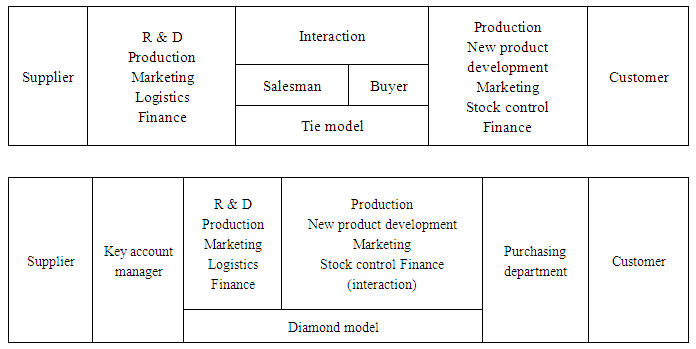 "Commitment", "agreement", "conflict and creativity," "communication and education", "to give authority" concepts forming the basic characteristics of a successful team are valid fro sales teams. (Taşkın, 2001).Teamwork has been discussed in many ways in literature and opinions have been put forward on. Sales teams also constitute a functional kind of teamwork. a large number of factors affecting the success, performance of the sales team have been handled, but "organizational commitment" and "job satisfaction" concepts has not been adequately handled in these factors. Organizational commitment, and job satisfaction affect their attitudes towards work of team members, as well as concepts such as communication leadership, motivation, education, promotion policies, fee affecting the success of the team members, and hence the success of the team. These concepts are discussed as a versatile below, the possible effects will be examined.
"Commitment", "agreement", "conflict and creativity," "communication and education", "to give authority" concepts forming the basic characteristics of a successful team are valid fro sales teams. (Taşkın, 2001).Teamwork has been discussed in many ways in literature and opinions have been put forward on. Sales teams also constitute a functional kind of teamwork. a large number of factors affecting the success, performance of the sales team have been handled, but "organizational commitment" and "job satisfaction" concepts has not been adequately handled in these factors. Organizational commitment, and job satisfaction affect their attitudes towards work of team members, as well as concepts such as communication leadership, motivation, education, promotion policies, fee affecting the success of the team members, and hence the success of the team. These concepts are discussed as a versatile below, the possible effects will be examined. 4. Job Satisfaction and Organizational Commitment
- Job satisfaction is an important concept examined in management literature as an attitude of employees toward the work. Because, job satisfaction has an impact on a large number of positive and negative on the employees. Undoubtedly the said effects affecting the individual will affect the success of the company. On the other hand, it is an attitude that demonstrates loyalty towards workplaces and the desire to remain in the workplace for those who work in the organizational commitment. In this context, job satisfaction and organizational commitment of team members are an important factor affecting the success of teams and thus the success of the businesses.
4.1. Job Satisfaction
- Whether individuals are satisfied with their works reveals positive or negative results. In this context, job satisfaction or dissatisfaction of the sales teams members will affect the success of the said teams and thus the success of the businesses. Job satisfaction defined as the general attitude towards the work of employee is positive or negative. (Erdoğan, 1996). "Job satisfaction" and "organizational commitment" are discussed as two core business attitude in organizational behavior. While job satisfaction consists of feelings, thoughts and beliefs of individual for individual's job, organizational commitment consists of feelings, thoughts and beliefs for the workplace (organization). (George et al, 2005). It can be said of the three components of job satisfaction and organizational commitment as business attitudes. These are: emotional, cognitive (mental) and behavioral components (Özkalp et al, 2001)). The individual's feelings and reviews regarding the said attitude object and emotional component; ideas, knowledge and beliefs, cognitive component; behaviors constitute behavioral component. In this context, while the said components constituting members' job satisfaction and organizational commitment in terms of sales team members affect the members, on the other hand they will affect the organization. Behaviors and performance constitute the most obvious indicators whether there is an internal audit of team member.
4.1.1. Factors Determining (Affecting) Job Satisfaction
- Factors determining job satisfaction is classified as demographic or individual and organizational factors. Individual factors include factors such as age, education, location, personality traits. The organizational factors include factors such as the relationships with superiors and colleagues, the integrity of the organization, promotion opportunities and wage. (Yamamura et al, 2004). Individual and organizational factors influencing job satisfaction is not limited to these. The factors such as gender and marital status, personality, values as individual factors and such as the work itself, cultures, groups, working hours, job security as organizational factors should be considered. Factors determining job satisfaction can be addressed as shown in Figure 2, by being subjected to a four-way classification with another approach (George et al, 2005).
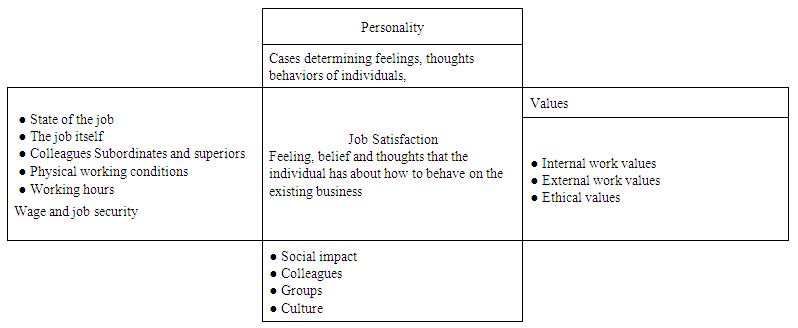 | Figure 2. |
4.1.2. Results of Job Satisfaction
- Job satisfaction or dissatisfaction arise in different ways in the behavior of employees. Behavior of employees arising the result of dissatisfaction and then absenteeism, labor turnover rate performance and productivity concepts will be discussed here.
4.1.2.1. Behaviors of Employees against Job Dissatisfaction
- Employees show the responses by acting in four different qualities in two different axes when they cannot provide satisfactory in the works. Active-passive and constructive-destructive behaviors as a result of job dissatisfaction of the employee are shown in Figure 3, (Robbins, 2003). ● Leave-taking. This behavior has an active and destructive nature, the employee indicates this behavior by leaving the work. ● Articulating. Articulating behavior carries a active and constructive nature. The employee shows a behavior-oriented solve problems.● Loyalty. This behavior has a passive and constructive nature. The employee waits to be resolved them as optimistic instead of solving problems. ● Ignoring. Employee' s behavior to ignore has a passive and destructive nature. This is the most dangerous behavior demonstrated against job dissatisfaction. Because employee tolerates to the negatives emerging the organization and remains silent to the possible deterioration. Therefore, they may reach to damaging sizes since behavior and effects can not be seen clearly.
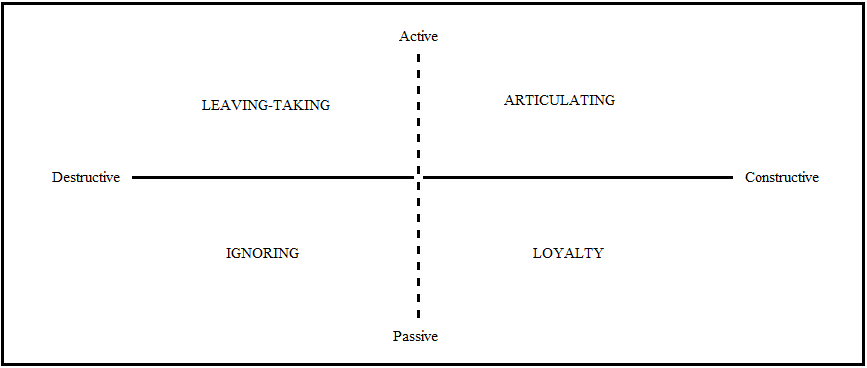 | Figure 3. Employee Behavior Against Job Dissatisfaction. Reference: Robbins, S.P. (2003). Organizational Behavior. Tenth Edition. New Jersey: Prentice Hall, 82. (Robbins, 2003) |
4.1.2.2. Job Satisfaction and Absences
- Absence in the workplace is defined as the absenteeism and the absence of the employee in time and place where it should be, and as planned by the employee. Absence covers all negatives and disruption caused by absenteeism in business program outside permit and normal annual holidays (Sabuncuoğlu, 2000). The absence can be handled in two groups as absenteism allowed by the organization and not being allowed by the organization in general. In particular, the negative impact of unauthorized absences on businesses is more than. (Blau et al, 1987).It was seen that as the job satisfaction increases, the rate of absence increases. When increasing the job satisfaction the employees who work on senior important tasks for enterprise in particular, absence of these employee increases (Erdoğan, 1997). It has been demonstrated that there is an inverse relationship between job satisfaction and absence in job satisfaction and absence relation. But although absenteeism affects job satisfaction, it does not assign only and alone. (Fournet et al, 1966).
4.1.2.3. Job Satisfaction and Productivity
- Productivity is expressed as contributions made for a corporate result compared to the resources used. Both qualitative and quantitative factors are measured in business with productivity. For example, the realization of business objectives, completion of the works etc. In this regard, it can be mentioned a relationship between job satisfaction and productivity. (Loke, 2001).But it does not mean that the employees having job satisfaction are productive at all times. The evidences obtained at the individual level states that the productive employees are happy employees. When moving from the individual level to the institution level. It is possible to encounter with a support that the job satisfaction will lead to the performance. However, it is seen that the enterprises being more satisfied employees are more effective compared to the enterprises being less satisfied employee when satisfaction and productivity data is collected for more the general of institution than individual level The thesis of the satisfaction causes productivity could not receive great support, it is because the employee is focused on individuals, not on businesses. In addition, individual level of productivity can be the structure which does not contain all the relationships and complexities of the their measurement and business procedures. When viewed from this aspect, even hard to say that satisfied employees are more productive, it can be said that the satisfied businesses are more productive (Robbins, 2003).
4.1.2.4. Job Satisfaction and Labor Turnover Rate
- Labor turnover rate or staff changing rate refers to the percentage of staff working during a certain period in an enterprise to staff leaving within that period. In a large number of factors affecting the labor turnover rate, there are also individual requests such as better wages, better jobs. Leaves of employment depending on the job satisfaction are evaluated in that's personal requests factors. (Sabuncuoğlu, 2000). It is detected in the survey that the labor turnover rate of the employees having more job satisfaction is low. Job satisfaction level reduces the labor turnover (Fournet et al, 1966) Firstly job satisfaction affects tend and intent to stay at work, this tend affects the leaving and labor turnover (Currivan, 1999).
4.1.2.5. Job Satisfaction and Performance
- The relationship between job satisfaction and performance is one of the most discussed topics in job satisfaction. The relations in the job satisfaction performance relation are examined under three headings. These are;Job satisfaction leads to higher performance.High performance leads to job satisfaction.● Relationship of job satisfaction and high performance is affected by other factors (such as wages). These relationships are shown in Figure 4. The opinions about Job satisfaction leads to high performance and high performance leads to job satisfaction did not find much support in the researches. (Ivancevich et al, 2002).
4.2. Organizational Commitment
- One of the concepts examined and discussed on it with the job satisfaction in behavioral sciences literature is also organizational commitment. The most widely known and used definition of organizational commitment is made by Mowday, Porter and Steers. According to the authors, organizational commitment is the belief and acceptance of the organization's goals and values, to make significant effort for the organization, willingness in this regard and strong and precise request to continue as a member of the organization. As seen from the definition, values play an important role in organizational commitment and take an important place. When it is taken into consideration, the individual matching the individual values to the values of the organization are likely to be more connected to the organization against person being different the individual values from the values of the organization. (Finegan, 2000). In this context, it can be said that integration of organizational values and individual values will further increase the organizational commitment. With another approach, organizational commitment is defined as the degree to feel loyalty to the organization that an employee works. (Currivan, 1999).
4.2.1. Dimensions of Organizational Commitment
- Meyer and Allen have argued that there are three dimension of organizational commitment. These are: affective commitment, continuance commitment and normative commitment. The dimensions of the commitment is significantly associated with the psychology of individuals. Emotional commitment includes a request, continuance commitment includes a requirement normative commitment also includes an obligation (Meyer et al, 1991). Emotional commitment reveals the individual's integration into the organization, being identical with it and emotional bond. Continuance commitment is a dependence containing requirement and caused by being aware of earnings which the person will loss when leaving the work. Normative commitment is a desire to continue to work because of a sense of moral responsibility of the individual. (Tett et al, 1993).Emotional commitment comprises an attitudinal process which the individuals start to think the relations with organizations in terms of value and target eligibility. The degree of compliance of the individual's goals and values and the individual's goals and values directly affects the individual's desire to keep with the organization. In general, the employees having a strong emotional commitment stay in organization because of having a desire to remain. Continuance commitment is intended to remain in the organization according to the costs related to the leave of employment. These costs can be grouped under two groups. Seniority, retirement plans, experiences, charges cannot be transferred to another job as a result of changing the work as the individuals working time increases or, individuals can not afford to lose and sacrificed all these fringe benefits, they can be handled in the first group. Costs in the second group create the lack of alternative job opportunities. Individuals who can not find alternative employment may feel compelled to stay in the present job. Normative commitment is intended to remain in the organization according to duty, loyalty and moral obligation sense of the individual. Employee's loyalty and duty sense underlying normative commitment affects the individual to remain in organization due to having a feeling as it would be wiser to remain (Clugston, 2000). Organizational commitment of employees is affected by very different factors and reasons in different ways and finally organizational commitment of employee composes and differs based on them.
5. Conclusions
- The concept of personal sales and salesperson discussed in marketing function which is one of the basic business functions are vital in continuing existence of the business. Due to the great importance, the businesses are aware of the benefits of competitive advantage that it will ensure themselves to have high performance, successful and personal salesmen. The individuals with different skills and expertise work with a team approach, so it further increases success. It is required to work in line with common objectives the individuals forming the team in this regard, to coordinate efforts of the members, to establish a good communication network between members. Thus, it would have benefited from the synergy which is the most important superiority oh teamwork.In this context, sales teams are also created from the team work and team philosophy. Thus, resolution of these issues that individuals will have difficulty in achieving one by one becomes easier and the success increases in this direction. Benefits to be provided by teamwork are considered in the establishment of the sales team.Job satisfaction and organizational commitment concepts have been handled and examined extensively in organizational behavior. The importance of these concepts has been demonstrated in organization success. Similarly, it is possible to say that job satisfaction and organizational commitments of members may significantly affect the success in sales teams. Job satisfaction or dissatisfaction has the potential to impact positively or negatively the behaviors of the team members. It is possible with more satisfied employees to eliminate the negative behavior and results that the dissatisfaction will emerge and the success of enterprises or teams will affect. On the other hand, organizational commitment having directly relationship with the loyalty of the employee influences the behavior of employees. The negative behaviors which will affect the businesses such as absence and leave of the employment and in this context the sales teams can be reduced and eliminated through organizational commitment. The most important point to be considered here is to create emotional commitment. If the organizational commitment of employees is created due to make things better for the organization instead of obligations or requirements, no doubt that success will come automatically.
 Abstract
Abstract Reference
Reference Full-Text PDF
Full-Text PDF Full-text HTML
Full-text HTML